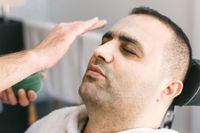The Role of Blue Light Therapy in Skin Cancer Treatment

With one in five Americans estimated to develop skin cancer before the age of 70, it’s clear that every person should be aware of the condition. While it can be deadly, it’s important to note that early treatment is extremely effective. That’s why people are encouraged to explore skin cancer treatment if they develop actinic keratosis—the most common form of precancerous skin lesions. If you have this problem, your dermatologist may recommend blue light photodynamic therapy to prevent cancer risks. The guide below offers more insight into this treatment option.
A Guide to Blue Light Therapy for Actinic Keratosis
How Do I Know If I Have Actinic Keratosis?
These small lesions commonly appear on the face, scalp, shoulders, and hands where sun exposure has occurred. They are dry and scaly patches of skin that have a rough texture. If you notice these lesions, have them diagnosed by a dermatologist as soon as possible.
What Happens During Treatment?
 Blue light photodynamic therapy for actinic keratosis is typically a two-part treatment. During the first portion, your dermatologist will apply a topical medication—known as aminolevulinic acid—to the affected area.
Blue light photodynamic therapy for actinic keratosis is typically a two-part treatment. During the first portion, your dermatologist will apply a topical medication—known as aminolevulinic acid—to the affected area.
Several hours after application, you will return to the dermatologist. During this phase, the treated area is exposed to a special blue light for about 15 minutes. When this happens, compounds in the medication react and cause an effect that kills cancer cells.
What Are the Advantages of Blue Light Skin Cancer Treatment?
Blue light therapy for actinic keratosis is considered safe and does not produce long-term side effects. Long-term scarring is not common.
Compared to other treatments—such as surgery—this method is less invasive, quicker, and more affordable. It also allows dermatologists to treat affected areas with precision.
What Should I Expect After Treatment?
Although photodynamic therapy is safe and requires little to no downtime, you might experience temporary redness or swelling of the treatment area. Medications used in therapy can increase sensitivity to sunlight, so avoid being outside as much as possible for about 40 hours after treatment.
Follow-up visits with your dermatologist will determine if the treatment was successful. If actinic keratosis is still present, additional therapy can be provided about eight weeks after the initial session.
If you have concerns about your skin, turn to Heibel Dermatology, LLC in Lincoln and Columbus, NE. Specializing in skin cancer treatment, Dr. Heibel will pinpoint and diagnose actinic keratosis and other growths. Using Blu-U® Photodynamic Therapy, this local dermatologist will target lesions to mitigate their cancer risks. If blue light therapy isn’t appropriate, this team also offers many other solutions for skin cancer—including Mohs surgery. To learn more about these capabilities, visit this provider online. For appointments, call (402) 488-6969 to reach the Lincoln office or (402) 564-1476 for the Columbus location.
About the Business


